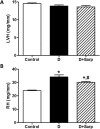Blocking 5-HT2 receptor restores cardiovascular disorders in type 1 experimental diabetes
- PMID: 27659784
- PMCID: PMC5034292
- DOI: 10.1038/srep33979
Blocking 5-HT2 receptor restores cardiovascular disorders in type 1 experimental diabetes
Abstract
This study aimed to determine whether the serotonergic modulation, through selective 5-HT2 receptor blockade, restores cardiovascular disturbances in type 1 diabetic rats. Diabetes was induced by alloxan (150 mg/kg, s.c.) and maintained for 4 weeks. 5-HT2 receptor was blocked by sarpogrelate (30 mg/kg.day; 14 days; p.o.). Systolic blood pressure (SBP), heart rate (HR), glycaemia and body weight (BW) were monitored periodically. Animals were sacrificed at the end of the study and the heart, right kidney and thoracic aorta were removed; plasma samples were also obtained. Left ventricular hypertrophy index (LVH) and renal hypertrophy index (RH) were determined. Vascular function was studied in aorta rings; additionally, superoxide anion (O2•-) production (by lucigenin-enhanced chemiluminescence) and lipid peroxidation (by thiobarbituric acid reactive substances assay) were measured. Neither alloxan nor sarpogrelate treatments altered HR, LVH or endothelium-independent relaxation. SBP, glycaemia, BW, RH, O2•- production and lipid peroxidation were significantly altered in diabetic animals compared with controls. Sarpogrelate treatment considerably decreased SBP, RH, O2•- production and lipid peroxidation. Endothelium-dependent relaxation was severely reduced in diabetic animal aortas compared to controls; sarpogrelate treatment markedly improved it. Our outcomes show that selectively blocking 5-HT2 receptors has beneficial effects on impaired cardiovascular parameters in diabetes.
Figures






Similar articles
-
Chronic sarpogrelate treatment improves renal sympathetic hyperactivity in experimental diabetes.Biomed Pharmacother. 2024 Jul;176:116814. doi: 10.1016/j.biopha.2024.116814. Epub 2024 May 30. Biomed Pharmacother. 2024. PMID: 38820974
-
Effect of sarpogrelate treatment on 5-HT modulation of vascular sympathetic innervation and platelet activity in diabetic rats.Biomed Pharmacother. 2022 Sep;153:113276. doi: 10.1016/j.biopha.2022.113276. Epub 2022 Jun 16. Biomed Pharmacother. 2022. PMID: 35717784
-
Astaxanthin-enriched-diet reduces blood pressure and improves cardiovascular parameters in spontaneously hypertensive rats.Pharmacol Res. 2011 Jan;63(1):44-50. doi: 10.1016/j.phrs.2010.09.003. Epub 2010 Sep 22. Pharmacol Res. 2011. PMID: 20868751
-
The 5-HT2 receptor antagonist sarpogrelate reduces urinary and plasma levels of thromboxane A2 and urinary albumin excretion in non-insulin-dependent diabetes mellitus patients.Clin Exp Pharmacol Physiol. 1999 May-Jun;26(5-6):461-4. Clin Exp Pharmacol Physiol. 1999. PMID: 10386239
-
In salt-sensitive hypertension, increased superoxide production is linked to functional upregulation of angiotensin II.Hypertension. 2003 Nov;42(5):945-51. doi: 10.1161/01.HYP.0000094220.06020.C8. Epub 2003 Sep 15. Hypertension. 2003. PMID: 12975388
References
-
- Stadler M. et al.. Persistent arterial stiffness and endothelial dysfunction following successful pancreas-kidney transplantation in Type 1 diabetes. Diabet. Med. 26, 1010–1018 (2009). - PubMed
-
- Ceriello A. et al.. The simultaneous control of hyperglycemia and GLP-1 infusion normalize endothelial function in type 1 diabetes. Diabetes Res. Clin. Pract. 114, 64–68 (2016). - PubMed
LinkOut - more resources
Full Text Sources
Other Literature Sources

